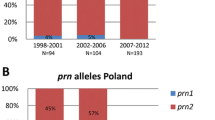Abstract
The aim of the study presented here was to analyze parapertussis infections occurring in the region of Warsaw, Poland, between 1995 and 2002 and to characterize the Bordetella parapertussis isolates using macrorestriction digestion of genomic DNA. Fourteen of the 17 patients with confirmed Bordetella parapertussis infection were between the ages of 5 and 9 years, and 14 had documented vaccination with the diphtheria-tetanus-pertussis whole-cell vaccine; for the remaining three patients vaccination data was not available. DNA fingerprinting performed using recommended standard methodology revealed a close relationship between the examined strains and reference strain ATCC 9305, thus confirming the conservative nature of Bordetella parapertussis.


Similar content being viewed by others
References
DeMelker HE, Conyn-van Spaendock MAE, Rümke HC, van-Wijngaarden JK, Mooi FR, Schellekens JFP (1997) Pertussis in the Netherlands: an outbreak despite high levels of immunization with whole cell vaccine. Emerg Infect Dis 3:175–178
Baron S, Njamkepo E, Grimprel E, Bégué P, Desenclos JC, Drucker J, Guiso N (1998) Epidemiology of pertussis in France in 1993–1994: Bordetella pertussis is still circulating in a country with a high level of coverage by an effective whole cell vaccine. Pediatr Infect Dis J 17:412–418
Andrews R, Herceq A, Roberts C (1997) Pertussis notifications in Australia. Commun Dis Intell 21:145–148
Bass JW, Wittler RR (1994) Return of epidemic pertussis in the United States. Pediatr Infect Dis J 13:343–345
Liese JG, Renner C, Stojanov S, Belohradsky BH, The Munich Vaccine Study Group (2003) Clinical and epidemiological picture of Bordetella pertussis and Bordetella parapertussis infections after introduction of acellular pertussis vaccines. Arch Dis Child 88:684–687
Polish Ministry of Health (1995, 1996, 1997, 1998, 1999, 2000) Annual reports of infectious diseases and intoxications in Poland. Epidemiology Department of the Institute of Hygiene and Sanitary Department of the Ministry of Health, Warsaw, Poland. http://www.medstat.waw.pl
Fiett J, Letowska I, Gniadkowski M, Hryniewicz W (2003) The new strategy for allele identification of the genes coding for pertussis toxin subunit S1 (ptx S1) and pertactin (prn) in Bordetella pertussis. J Microbiol Methods 55:651–666
Mooi FR, Hallander H, Wirsing von König CH, Hoet B, Guiso N (2000) Epidemiological typing of Bordetella pertussis isolates: recommendations for standard methodology. Eur J Clin Microbiol Infect Dis 19:174–181
Kourova N, Caro V, Weber C, Thiberge S, Chuprinina R, Tseneva G, Guiso N (2003) Comparison of the Bordetella pertussis and Bordetella parapertussis isolates circulating in Saint Petersburg between 1998 and 2000 with Russian vaccine strains. J Clin Microbiol 41:3706–3711
Mäkinen J, Mertsola J, Soini H, Arvilommi H, Viljanen MK, Guiso N, He Q (2003) PFGE and pertactin gene sequencing suggest limited genetic variability within the Finnish Bordetella parapertussis population. J Med Microbiol 52:1059–1063
Heininger U, Klemens S, Schmitt-Grohe S, Lorenz C, Rost R, Christenson P, Uberall M, Cherry JD (1994) Clinical characteristics of Bordetella parapertussis compared with illness caused by Bordetella pertussis. Pediatr Infect Dis J 13:306–309
He Q, Viljanen MK, Aittanen B, Mertsola J (1998) Whooping cough caused by Bordetella pertussis and Bordetella parapertussis in an immunized population. J Am Med Assoc 280:635–637
Hartstein AI, Chetchotisakd P, Phelps CL, LeMonte AM (1995) Typing of sequential bacterial isolates by pulsed-field gel electrophoresis. Diagn Microbiol Infect Dis 22:309–314
Mastrantonio P, Stefanelli P, Guliano M, Herrera Rojas Y, Ciofi Degli Atti M, Anemona A, Tozzi AE (1998) Bordetella parapertussis infection in children: epidemiology, clinical symptoms, and molecular characteristics of isolates. J Clin Microbiol 36:999–1002
Yuk MH, Heininger U, Martinez de Tejada G, Miller JF (1998) Human but not ovine isolates of Bordetella parapertussis are highly clonal as determined by PCR-based RAPD fingerprinting. Infection 26:270–273
Author information
Authors and Affiliations
Corresponding author
Rights and permissions
About this article
Cite this article
Letowska, I., Hryniewicz, W. Epidemiology and characterization of Bordetella parapertussis strains isolated between 1995 and 2002 in and around Warsaw, Poland. Eur J Clin Microbiol Infect Dis 23, 499–501 (2004). https://doi.org/10.1007/s10096-004-1141-5
Published:
Issue Date:
DOI: https://doi.org/10.1007/s10096-004-1141-5




